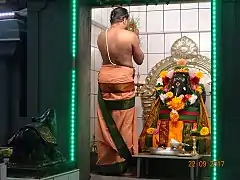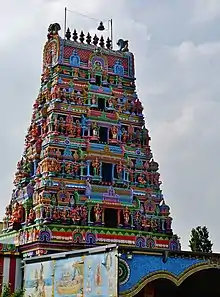Hinduism in Germany
Hinduism is a minority religion in Germany. It is practised by 0.1% of the population of Germany.[1]


| Hinduism by country |
|---|
  |
| Full list |

Demographics
From the 1950s, Indian Hindus were migrating to Germany. Since the 1970s, Tamils from Sri Lanka arrived as asylum seekers to Germany (Most of them were Hindus). In 2000, there were 90,000 Hindus in Germany.[2] In 2007, there were 6,000 Hindus in Berlin.[3] In 2009, around 5,000 Hindus lived in Lower Saxony.[4]
According to the statistics of REMID,[5] in 2011 there were an estimated 130,000 Hindus in Germany. About 42,000–45,000 are Sri Lankan Tamils; 60,000–80,000 are Indian; 7,500+ are Whites and others; and some 7,000 - 10,000 are Afghan Hindus.
ISKCON

The first Hare Krishna temple in Germany was built 1970 in Hamburg. The ISKCON guru Sacinandana Swami translated the Bhagavad Gita into German.[6]
Balinese Hinduism

Pura Tri Hita Karana There are about 700 Balinese Hindu families[7] living in Germany, with the one temple located in Hamburg in front of the Museum of Ethnology, Hamburg and the second, Pura Tri Hita Karana located in Erholungspark Marzahn, Berlin.[8][9] Pura Tri Hita Karana is a functioning Hindu temple located in the Balinese Garden of the park. It is one of the few Hindu temples of Balinese architecture built outside Indonesia.
Famous German Hindus
References
- https://fowid.de/meldung/religionszugehoerigkeiten-deutschland-2017
- Martin Baumann (April 2001). "Disputed Space for Beloved Goddesses". Martin Baumann(2001 International Conference at LSE). Retrieved 24 July 2012.
- "Construction Starts on Berlin's First Hindu Temple". Spiegel Online. Germany. 11 February 2007.
- "A New Hindu Temple for Germany". Spiegel Online. Germany. 23 March 2009.
- https://www.remid.de/info_zahlen/hinduismus/
- Ray 2008
- https://www.hinduismtoday.com/modules/smartsection/item.php?itemid=5458
- http://balinesehome.blogspot.in/2008/09/first-temple-in-hamburg-germany.html
- http://blog.baliwww.com/religion/1751